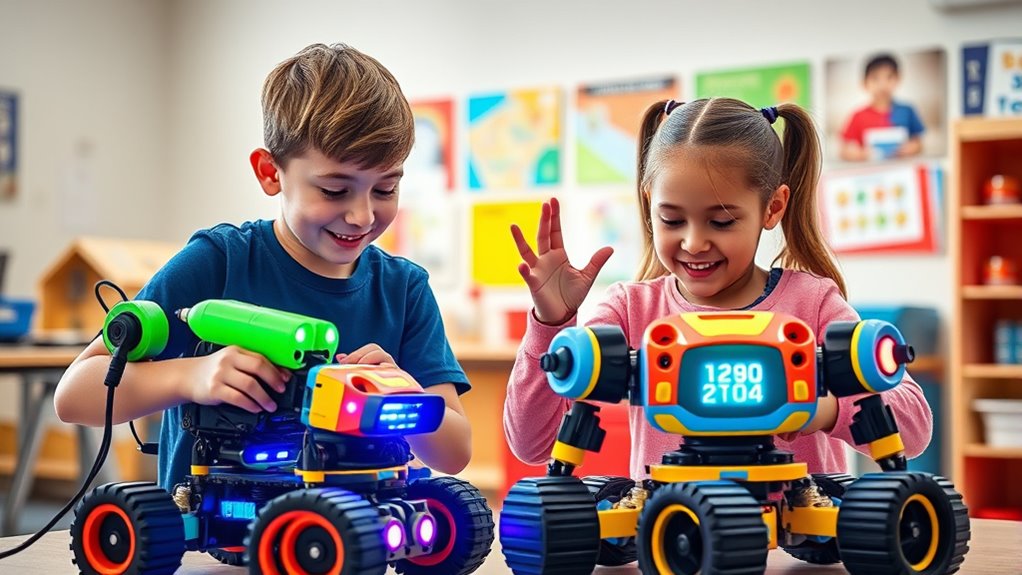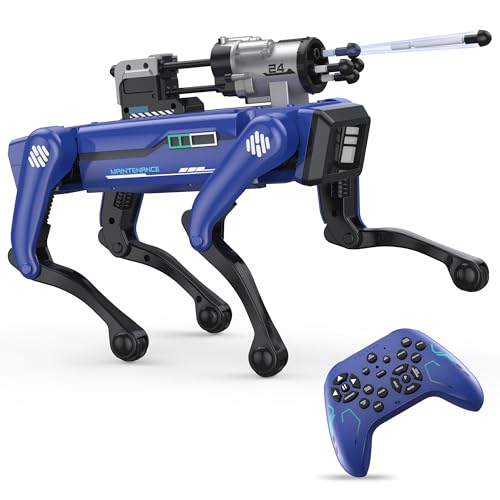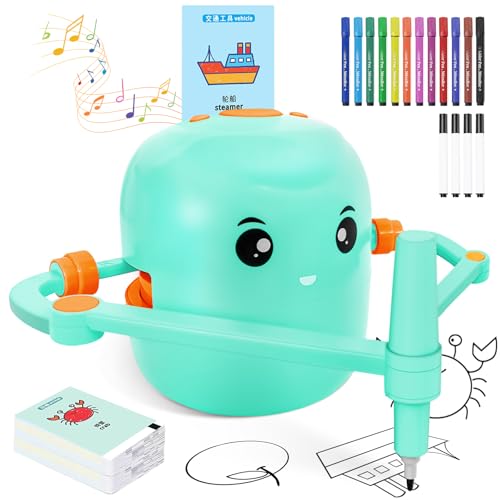If you’re looking for the best interactive STEM robots for kids that make learning fun, I’ve found some great options. From the Dash Robot for coding, Lucky Doug solar-powered kits for building, to the versatile 5-in-1 AI robot set, there’s something for every age and interest. These toys promote critical thinking, creativity, and hands-on problem-solving. Keep exploring, and you’ll discover details that can help you choose the perfect fit for your child’s curiosity and skills.
Key Takeaways
- The list features age-appropriate STEM robots that promote coding, engineering, and creative problem-solving skills.
- Many robots offer hands-on building, interactive play, and programmable features to keep children engaged.
- Key features include durability, safety, and compatibility with popular coding platforms like Blockly and Scratch.
- The selection includes versatile options such as solar-powered kits, AI-enabled models, and tactile, screen-free robots.
- These robots foster critical thinking, teamwork, and curiosity through fun, educational activities suitable for various age groups.
Dash Robot – Coding Robot for Kids 6
If you’re looking for a STEM robot that’s perfect for kids as young as 6, Dash Robot is an excellent choice. I love how its sleek design and sturdy build make it durable for young learners. It’s voice-activated and easy to control, encouraging kids to experiment with movement, singing, and dancing. With built-in obstacle avoidance, Dash navigates terrain smoothly, making coding and exploration fun. The robot’s accessories and expandable features spark creativity, while its compatibility with multiple apps offers a range of learning experiences. Dash not only teaches coding basics but also keeps kids engaged for hours through hands-on play and problem-solving.
Best For: young children aged 6 and above who are interested in exploring coding, robotics, and STEM activities through hands-on, interactive play.
Pros:
- Durable and sturdy design suitable for young learners
- Supports a variety of apps for progressive learning and creativity
- Features obstacle avoidance and terrain navigation for engaging exploration
Cons:
- Firmware updates can occasionally be challenging to implement
- Limited advanced programming features for older or more experienced users
- Requires compatible devices and apps, which may need updates or additional setup
Lucky Doug Solar Power Kits STEM Robot Kit Toys for Kids 8-13
The Lucky Doug Solar Power Kits STEM Robot Kit is an excellent choice for kids aged 8 to 13 who are enthusiastic to explore renewable energy and engineering through hands-on building. With 12-in-1 robot designs and 190 parts, it sparks creativity and problem-solving skills as children assemble crawlers, rollers, and floaters. Powered solely by solar energy, it introduces eco-friendly concepts, though some users find the solar panel’s power limited. The set encourages teamwork, patience, and curiosity, making science engaging. While assembly can be tricky and parts fragile, many kids enjoy the challenge and the satisfaction of creating functional robots that move under sunlight.
Best For: kids aged 8 to 13 who are interested in STEM, renewable energy, and hands-on engineering projects.
Pros:
- Encourages creativity, problem-solving, and interest in science and engineering.
- Powered by solar energy, promoting eco-friendly learning and sustainability awareness.
- Provides a fun, educational experience with multiple robot designs and hands-on assembly.
Cons:
- Assembly can be challenging and may require adult assistance for younger children.
- Some parts and the solar panel may be fragile or underpowered, impacting robot performance.
- The motor strength can be weak, causing robots to stall or gears to not turn smoothly.
5-in-1 STEM AI Robot Building Set (478Pcs) for Kids
Looking for a versatile STEM robot kit that sparks creativity and learning? The in-1 STEM AI Robot Building Set offers 478 pieces to build five different models, including animals, AI robots, and engineering vehicles. It’s designed with easy-to-follow instructions that promote hands-on learning, logical thinking, and problem-solving. Kids can control the robots via remote or app, enjoying features like 360° movement, gravity sensors, and AI programming. Plus, the interactive snail displays emotions, making play engaging and educational. Perfect for children aged 6 and up, this set encourages STEM skills while providing fun, versatile play indoors and outdoors.
Best For: children aged 6 and up, especially boys aged 8-13, who enjoy STEM activities, creative building, and interactive play.
Pros:
- Offers 478 pieces to build five diverse models, fostering creativity and engineering skills.
- Features remote and app control with advanced functions like 360° movement and AI programming for an engaging experience.
- Includes expressive interactive snail with emotion display and mute option, promoting emotional development and quiet play.
Cons:
- Assembly may require adult supervision for younger children due to complexity.
- Some electronic features depend on app compatibility, which may require device updates.
- The set’s size and variety might be overwhelming for very young children or those new to building kits.
Learning Resources Cooper STEM Robot for Kids
Children aged 5 and up will find the Learning Resources Cooper STEM Robot especially appealing, thanks to its screen-free design that introduces fundamental coding concepts through tactile play. This compact, durable robot uses sensors to detect light, obstacles, and lines, offering four interactive modes: line tracking, optical sensing, obstacle avoidance, and robot-to-robot communication. It can talk, sing, dance, and produce sounds, making learning engaging. With simple command buttons and 40 coding cards, Cooper encourages logical thinking, sequencing, and decision-making. The included STEM kit and challenges foster creativity and problem-solving, making it a versatile tool for classroom, homeschool, or family fun.
Best For: young children aged 5 and above, educators, and families seeking a screen-free, engaging introduction to coding and STEM concepts through tactile play and interactive learning.
Pros:
- Promotes critical thinking, problem-solving, and early coding skills without screens
- Durable, compact design suitable for various learning environments and rough play
- Offers multiple interactive modes and activities that foster creativity and collaboration
Cons:
- Children may lose interest after initial exploration unless guided to use all features
- Limited complexity, making it less suitable for advanced coding learners
- Requires supervision or instruction to maximize learning outcomes and engagement
LEXiBOOK Powerman Jr. Interactive Toy Robot
If you’re searching for an engaging and educational robot suitable for young kids, the LEXiBOOK Powerman Jr. is a fantastic choice. Designed for children aged 3 and up, it acts as a friendly explorer that dances, plays music, and mimics animal sounds. Its interactive animal guessing game encourages curiosity about animals like cats, dogs, and llamas. Kids can record and replay their voices, program up to 40 actions, and even create custom dances. Controlled via an infrared remote, it moves in all directions, making play dynamic and fun. With its lovable design and educational features, Powerman Jr. makes learning about the world exciting and accessible for young explorers.
Best For: young children aged 3 and above who enjoy interactive, educational, and entertaining toys that promote curiosity about animals and the world.
Pros:
- Engaging and educational features like animal guessing, voice recording, and programmable routines
- Controlled via a user-friendly infrared remote for dynamic play
- Lovable design with light and sound effects that appeal to young kids
Cons:
- Requires 3 AA batteries for the robot and 2 AA batteries for the remote, which are not included
- Limited to recognizing specific animals such as cats, dogs, llamas, unicorns, and sloths
- May have a learning curve for very young children to fully utilize programmable features
Learning Resources Code & Go Robot Mouse Activity Set
The Learning Resources Code & Go Robot Mouse Activity Set stands out as an ideal choice for kids ages 4 and up who are just beginning to explore coding and problem-solving through hands-on play. With 83 pieces, including maze tiles, walls, tunnels, and a programmable robot mouse, it promotes critical thinking and early programming skills. Kids can build mazes, program Colby to navigate, and learn concepts like algorithms and logic. The set is easy to assemble and offers guided challenges that grow with the child’s ability. It’s a fun, educational tool that encourages creativity, spatial awareness, and foundational coding knowledge, making learning engaging and interactive.
Best For: young children aged 4 and up who are beginning to learn coding, problem-solving, and STEM concepts through engaging, hands-on activities.
Pros:
- Encourages development of critical thinking, sequencing, and problem-solving skills
- Includes a variety of components for creative maze building and programmable play
- Promotes early understanding of coding concepts like algorithms and logic
Cons:
- Requires batteries (not included), which may be an inconvenience to purchase separately
- Younger children may need adult assistance with assembly and operation
- Occasionally the robot mouse may overshoot turns or execute sequences imperfectly on larger mazes
Bottleboom STEM 13-in-1 Solar Power Robot Toys for Kids
For parents and educators seeking a versatile and educational robotic kit, Bottleboom STEM 13-in-1 Solar Power Robot Toys stands out as an excellent choice. This kit lets kids build 13 different robots that can move on land or water, following an easy step-by-step manual. Made with non-toxic, smooth ABS materials, it’s safe for children ages 8-12. The solar-powered engines introduce renewable energy concepts, encouraging eco-conscious learning. Kids develop creativity, problem-solving, and fine motor skills while having fun building and rebuilding. It’s perfect for collaborative projects and family bonding, making science exciting and tangible through real-world solar energy exploration.
Best For: parents, educators, and STEM enthusiasts seeking a versatile, eco-friendly, and educational robot kit for children aged 8-12 to foster creativity, problem-solving, and renewable energy awareness.
Pros:
- Promotes hands-on STEM learning through building 13 different robots with step-by-step guidance.
- Made with safe, non-toxic ABS materials for durable and smooth play.
- Encourages environmental consciousness by utilizing solar power instead of batteries.
Cons:
- Assembly may be challenging for some younger children without adult supervision.
- Limited to solar power, which can be less reliable on cloudy days or indoors.
- Requires careful handling of small parts during disassembly and rebuilding.
Smart Robot Dog with Voice & Remote Control, STEM Toy for Kids 6-12
A standout choice among interactive STEM robots for kids ages 6 to 12 is the Smart Robot Dog with Voice & Remote Control, thanks to its lifelike movements and programmable features. It performs over 30 actions, like swimming, shaking hands, and doing handstands, all accompanied by fun sound effects. Made from durable, kid-safe materials, it includes LED eyes and impact-resistant joints for safety and durability. Kids can control it with voice commands or a remote within 25 meters, and program up to 100 action sequences, fostering creativity and problem-solving. Its engaging tricks, like shooting soft bullets, make learning both fun and interactive.
Best For: kids aged 6 to 12 who enjoy interactive, programmable toys that combine fun, learning, and durability.
Pros:
- Offers lifelike movements and over 30 actions with sound effects, enhancing playability.
- Programmable up to 100 action sequences to promote creativity and STEM skills.
- Built with impact-resistant, non-toxic materials ensuring safety and durability for active kids.
Cons:
- Requires USB-C charging, which may be less convenient for some users.
- May be less sophisticated than advanced robotics, limiting complex programming features.
- Suitable primarily for indoor or outdoor use within a 25-meter remote control range.
Drawing Robot for Kids with Learning Cards and Pens
Kids who love drawing and learning will find the Drawing Robot with Learning Cards and Pens to be an engaging STEM toy that combines creativity with education. Made from child-safe ABS plastic, it’s easy to set up—just insert a learning card, press a button, and watch it draw guided shapes and objects. The robot announces each image, plays cheerful music, and helps kids learn to draw step-by-step. With 150 themed cards and washable markers, children can color and personalize their artwork, boosting confidence and fine motor skills. It’s a fun way to develop artistic talents while encouraging independent, educational play.
Best For: parents and educators seeking an engaging, educational STEM toy that nurtures creativity, artistic skills, and confidence in children aged 3 and up.
Pros:
- Encourages artistic development and fine motor skills through guided drawing and coloring activities.
- Supports early STEM learning with interactive, step-by-step image guides and cheerful music.
- Made from durable, child-safe ABS plastic with easy setup for independent use.
Cons:
- May require adult supervision for younger children during initial setup.
- Limited to drawing and coloring activities; may need additional toys for broader creative play.
- The size of the set might be cumbersome for small storage spaces.
Learning Resources Botley Coding Robot and STEM Building Toy
If you’re looking for an engaging, screen-free way to introduce young children to coding and problem-solving, the Learning Resources Botley Coding Robot and STEM Building Toy is an excellent choice. It’s designed for kids 5 and up, with features like 80-step programming, loops, obstacle detection, and a black-line follow mode. The set includes a 45-piece activity pack with coding cards, obstacles, and building accessories, making learning interactive and fun. Children can program Botley to navigate courses, follow paths, and perform tricks, fostering creativity, critical thinking, and sequencing skills. Its simple setup and charming design make it a favorite among parents and kids alike.
Best For: young children aged 5 and above who are beginning to explore coding, critical thinking, and problem-solving in a fun, screen-free environment.
Pros:
- Encourages creativity, critical thinking, and sequencing skills through interactive play.
- Easy to set up and operate with an engaging design that appeals to kids.
- Includes a comprehensive activity set with coding cards, obstacles, and building accessories for varied learning experiences.
Cons:
- High battery consumption requiring frequent replacements (about 20 AAA batteries per month).
- Some features like black-line follow and obstacle detection can be finicky and may need adjustments.
- Limited maze size due to small pathways on the activity cards, restricting complex course building.
Robot Building Kit for Kids Aged 8-16 with App or Remote Control STEM Educational Toy
Designed for children aged 8 to 16, the Henoda Robot Building Kit offers an engaging way to explore STEM concepts through hands-on building and interactive play. With over 468 pieces, colorful stickers, and detailed instructions, it promotes creativity, coordination, and practical skills. The robots feature glowing eyes, flexible joints, and transforming capabilities, moving in all directions with 360-degree rotation. Controlled via Bluetooth app, remote, or voice, the kit provides flexible operation and encourages programming and problem-solving. Made from safe, durable materials, it’s an excellent educational gift that sparks interest in robotics while offering fun and learning combined.
Best For: children aged 8 to 16 who are interested in STEM, robotics, building, and interactive play, and want an educational toy that combines creativity and hands-on learning.
Pros:
- Supports STEM education with building, coding, and interactive features.
- Multiple control options including app, remote, voice, and sensors for versatile play.
- Safe, durable materials with detailed instructions make assembly suitable for children.
Cons:
- Some users report app incompatibility issues and limited voice control functionality.
- The robot is primarily a remote-control toy and may not fully support programming or hand movement as advertised.
- App language and recognition problems can hinder the user experience for some children.
Learning Resources Code & Go Robot Mouse Activity Set for Kids
Are you searching for an engaging way to introduce young children to coding and problem-solving? The Learning Resources Code & Go Robot Mouse Activity Set is perfect for kids aged 4 and up. It includes 83 durable, BPA-free pieces, like a rechargeable robot mouse, maze grids, walls, tunnels, coding cards, and activity guides. Kids can easily program the mouse using colorful buttons and matching cards, promoting sequencing, critical thinking, and STEM skills. This hands-on set encourages exploration, creativity, and problem-solving in a fun, safe environment. It’s ideal for home or classroom use, helping children develop a lifelong love of learning through interactive play.
Best For: young children aged 4 and up, educators, and parents seeking engaging STEM activities that introduce coding, problem-solving, and critical thinking skills.
Pros:
- Encourages early coding skills through easy-to-use matching cards and programmable mouse
- Includes durable, BPA-free components designed for long-lasting safe play
- Supports hands-on learning and problem-solving in both home and classroom settings
Cons:
- Some children may require adult guidance to fully grasp programming concepts initially
- The set’s size and number of pieces may be overwhelming for some young children without proper supervision
- Limited to basic coding and problem-solving activities; advanced learners may outgrow it quickly
Smart Robot Dog – Interactive STEM Pet with Voice Control, 30+ Actions & App Programming
The Smart Robot Dog stands out as an excellent choice for kids who love interactive pets that combine fun and learning. It offers over 30 lifelike actions like kung fu, handshakes, and pranks, all controllable via voice commands, touchscreen app, or remote. Kids can explore coding by creating custom action sequences, boosting their logic and creativity. Its durable, kid-safe design includes fast USB-C charging and a long-lasting battery, making it perfect for everyday play. With versatile control options and engaging features, this robot grows with children, providing years of smart, fun, and educational entertainment.
Best For: kids aged 6-12 who enjoy interactive, educational, and programmable robotic pets that combine fun with STEM learning.
Pros:
- Offers over 30 realistic actions and fun pranks to keep children engaged
- Supports multiple control options including voice commands, app, and remote for versatile play
- Encourages STEM skills through customizable coding and action programming
Cons:
- May require adult supervision for coding and app setup
- Slightly higher price point compared to basic toys, reflecting its advanced features
- Needs regular charging and updates to maintain optimal functionality
Factors to Consider When Choosing Interactive STEM Robots for Kids

When selecting an interactive STEM robot for a child, I always consider factors like age appropriateness and the quality of educational content to guarantee it’s both safe and engaging. I also check how easy it is to control and program, along with the robot’s durability and safety features. Additionally, compatibility options can enhance the learning experience, so I make sure those are suitable for the child’s devices and skills.
Age Appropriateness
Choosing the right interactive STEM robot hinges on matching the robot’s recommended age range with the child’s developmental stage. For younger kids aged 3-5, opt for simple, tactile robots with limited functions to help develop basic motor skills and spark curiosity. Kids aged 6-8 benefit from robots that introduce foundational coding through intuitive controls or visual programming, making learning accessible and fun. For children 8-13, look for robots with more advanced programming, multi-step tasks, and customization options that challenge and grow their skills. It’s also important to take into account your child’s interest and maturity level. Selecting a robot that aligns with their developmental stage guarantees the experience is safe, engaging, and appropriately challenging, laying a strong foundation for future STEM learning.
Educational Content Quality
High-quality educational content in STEM robots should introduce core concepts like coding, engineering, and problem-solving in a way that’s suitable for a child’s age and learning level. It needs to be engaging yet clear, offering progressive difficulty levels to support ongoing growth and skill development. Well-designed content provides accurate instructions and explanations, making complex ideas accessible and fostering understanding. Incorporating real-world applications and environmental awareness makes learning relevant and meaningful, helping kids see the practical value of STEM principles. Additionally, content should be regularly updated and supported with supplementary resources to stay current and exhaustive, aligning with evolving STEM standards. When choosing a robot, look for educational material that is thoughtfully crafted to inspire curiosity and build confidence in STEM learning.
Control and Programming
Selecting the right control and programming features can make a big difference in a child’s engagement and learning with STEM robots. I look for robots that offer multiple control options like remote control, voice commands, or app-based programming to match different learning styles. The programming interface should suit the child’s age—simple buttons for beginners or drag-and-drop coding for more advanced users. Customizable programming sequences allow kids to create and modify actions, boosting creativity and problem-solving skills. Sensors, obstacle avoidance, and feedback mechanisms enhance interactivity and autonomous behavior. Most importantly, the programming features should teach foundational coding concepts such as sequencing, loops, algorithms, and variables, helping kids build a strong STEM understanding while having fun.
Durability and Safety
Since kids can be quite energetic during play, prioritizing durability and safety guarantees the robot can withstand rough handling and last longer. I look for robots made from non-toxic, BPA-free plastics with smooth edges to prevent injuries. Reinforced joints and sturdy moving parts are essential to resist impact and repeated use without breaking. Safety features like auto-shutdown and overcharge protection help prevent overheating and electrical hazards. I also guarantee the robot meets safety standards and certifications for children’s toys, giving peace of mind. The durability of the battery and charging system matters too, as it impacts consistent performance and safe operation over time. Focusing on these factors ensures the robot is not only fun but also safe and built to last through all the adventures kids will have.
Compatibility Features
When selecting an interactive STEM robot for children, it’s important to take into account its compatibility features to guarantee smooth operation and future expandability. Look for robots that support various control methods like remote control, smartphone apps, voice commands, and programmable interfaces, offering flexibility in how kids interact with them. Compatibility with multiple operating systems such as iOS, Android, or Fire OS ensures seamless device integration. Check if the robot provides open communication protocols or SDKs, enabling custom programming and expansion. Additionally, ensure it works with popular coding platforms like Blockly or Scratch, making coding accessible and fun. Finally, verify the hardware supports future updates, accessories, or expansion modules to maximize the robot’s long-term usability and learning potential.
Creative Expansion Options
Creative expansion options are essential for making STEM robots more engaging and versatile. They allow kids to customize their robots with building attachments or modular components, sparking imagination and hands-on learning. Many robots support additional accessories or kits, enabling children to develop new features as their skills grow. App-based upgrades or downloadable content also offer ongoing opportunities for creative programming and design tweaks. Modular design elements, like interchangeable limbs or sensors, encourage experimentation and help kids grasp engineering principles through direct manipulation. Expansion packs and DIY add-ons extend a robot’s lifespan and educational value, motivating kids to explore and innovate continuously. Overall, these options foster creativity, adaptability, and deeper understanding of STEM concepts, making learning both fun and meaningful.
Price and Value
Choosing the right interactive STEM robot for kids depends largely on understanding its price and the value it offers. Prices range from around $30 for basic models to over $200 for more advanced options, which impacts overall value. Higher-priced robots typically include features like programmable routines, app integration, and increased durability, providing better long-term educational benefits. To assess cost-effectiveness, compare the number of functions and developmental advantages relative to the price. Sometimes, investing a bit more upfront can yield a more durable and expandable robot, offering greater value over time. It’s also essential to match the robot’s features with your child’s age and learning goals, ensuring the investment delivers meaningful educational and entertainment benefits that align with your expectations.
Frequently Asked Questions
What Safety Features Are Included in These STEM Robots for Kids?
These STEM robots come with several safety features I look for. They often have rounded edges to prevent cuts, and sensors that stop movement if anything gets too close. Most are made from non-toxic, BPA-free materials, ensuring safe play. I also appreciate built-in timers or auto shut-off functions that prevent overheating or overuse. Overall, these features give me peace of mind knowing my kids can explore safely while learning and having fun.
How Durable Are These Robots Under Rough Play Conditions?
Picture a sturdy fortress standing strong against storms—that’s how durable I find these robots. They’re built with tough plastic and reinforced joints, making them resilient even when kids play roughly. While no toy is entirely indestructible, I’ve seen these withstand drops and rough handling well enough to keep the fun going. Just like a trusted armor, they’re designed to endure the adventures and energetic play of curious kids.
Are There Age-Specific Recommendations for Each Robot Model?
Yes, there are age-specific recommendations for each robot model. I always check the manufacturer’s guidelines to verify the robot matches my child’s age, safety, and skill level. For younger kids, simpler, durable models work best, while older children can handle more advanced robots with coding features. Following these recommendations helps me guarantee my child has a fun, safe, and educational experience with their robot.
Can These Robots Be Integrated With Other Educational Tools?
Yes, many of these robots can be integrated with other educational tools. I’ve found that apps, coding platforms, and compatible devices often work seamlessly with these robots, creating a more thorough learning experience. This integration helps reinforce concepts and keeps kids engaged. Just make sure to check each robot’s compatibility and software requirements, so you can maximize their educational potential and create a cohesive, fun learning environment.
What Are the Maintenance and Charging Requirements for These Robots?
Think of these robots as high-performance cars—they need regular check-ups and fuel to run smoothly. I find that most require charging after about 1-2 hours of use, and keeping the batteries in good condition extends their life. Maintenance is straightforward, usually involving cleaning sensors and updating software. A little TLC keeps these tech toys running at their best, ensuring your child’s learning adventure never hits a dead end.
Conclusion
In my experience, choosing the right STEM robot can truly spark a child’s passion for learning. Did you know that 90% of kids who engage with educational robots show increased interest in science and technology? With options like coding, building, and interactive play, these robots make learning both fun and meaningful. So, consider your child’s age and interests to find the perfect match—it’s a small investment that can inspire a lifelong love of STEM.
























